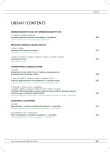Cerebrospinal Fluid Drainage System Peritoneal Catheter Malfunction in Children
Authors:
E. Brichtová; Z. Mackerle; J. Tůma
; P. Gál
Authors‘ workplace:
Neurochirurgické oddělení Kliniky dětské chirurgi e, ortopedie a traumatologie FN Brno
Published in:
Cesk Slov Neurol N 2009; 72/105(5): 461-465
Category:
Short Communication
Overview
Peritoneal implantation of a cerebrospinal fluid drainage system distal catheter is generally the most suitable choice. Even if generally accepted, there are possible specific complications. Peritoneal catheter malfunction manifests itself as a drainage system malfunction (signs and symptoms of increased intracranial pressure) or in local abdominal pain and peritoneal signs. Peritoneal catheter malfunction is caused by catheter rupture and dislocation in abdominal cavity, scar tissue adhesions inducing cerebrospinal fluid pseudocyst or by infection. A group of 48 pediatric patients with peritoneal catheter malfunction treated in the Department of Neurosurgery, Clinic of Pediatric Surgery, Orthopedics and Traumatology, Brno Faculty Hospital, in the period 1/2003–12/2007, is presented and the malfunction reasons, time from drainage system implantation and therapeutic approach are discussed.
Key words:
peritone al catheter – catheter failure – peritone al pse udocyst – CSF drainage in child – laparoscopy
Sources
1. Mazza C, Pasqu alin A, Da Pi an R. Results of tre atment with ventriculo atri al and ventriculoperitone al shunt in infantile nontumoral hydrocephalus. Childs Brain 1980; 7(1): 1– 14.
2. Clarnette TD, Lam SK, Hutson JM. Ventriculo- peritone al shunts in children reve al the natural history of closure of the processus vaginalis. J Pedi atr Surg 1998; 33(3): 413– 416.
3. Moss SD, Pattisapu JV, Walker ML. Use of the peritone al trocar in pedi atric shunt procedures. Concepts Pedi atr Ne urosurg 1988; 8: 23– 28.
4. Di Rocco C, Marchese E, Velardi F. A survey of the first complicati on of newly implanted CSF devices for the tre atment of nontumoral hydrocephalus. Co operative survey of the 1991– 1992 Educati on Committee of the ISPN. Childs Nerv Syst 1994; 10(5): 321– 327.
5. Plánka L, Starý D, Tůma J, Macháček R, Gál P. Laparoscopic versus laparotomic appendectomy for generalized peritonitis in children. Scripta Medica 2009; 82(2): 83– 89.
6. Vinchon M, Dhellemmes P. Abdominal complicati ons of Peritone al Shunts. In: Cinalli G, Maixner WJ, Sainte- Rose C (eds). Pedi atric hydrocephalus. Milano: Springer 2004: 316– 327.
7. Pi att JH. Cerebrospinal fluid shunt failure: late is different from e arly. Pedi atr Ne urosurg 1995; 23(3): 133– 139.
8. Besson R, Hladky JP, Dhellemmes P, Debe ugny P. Peritone al pse udocyst: peritone al shunt complicati ons. Eur J Pedi atr Surg 1995; 5(4): 195– 197.
9. Fischer EG, Shillito J jr. Large abdominal cysts: a complicati on of peritone al shunts. J Ne urosurg 1969; 31(4): 441– 444.
10. Hadani M, Findler G, Muggi a- Sullam M, Sahar A. Acute appendicitis in children with a ventriculoperitone al shunt. Surg Ne urol 1982; 18(1): 69– 71.
11. Jones RF, Stening WA, Kwok BC, Sands TM. Third ventriculostomy for shunt infecti on in children. Ne urosurgery 1993; 32(5): 855– 860.
Labels
Paediatric neurology Neurosurgery NeurologyArticle was published in
Czech and Slovak Neurology and Neurosurgery

2009 Issue 5
Most read in this issue
- Lumbar Spinal Stenosis and Neurogenic Claudicati on
- Dissoci ative Seizures
- Indication of Decompressive Craniectomy in Traumatic Brain Injury
- The Genetics of Parkinson’s Disease
